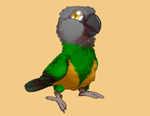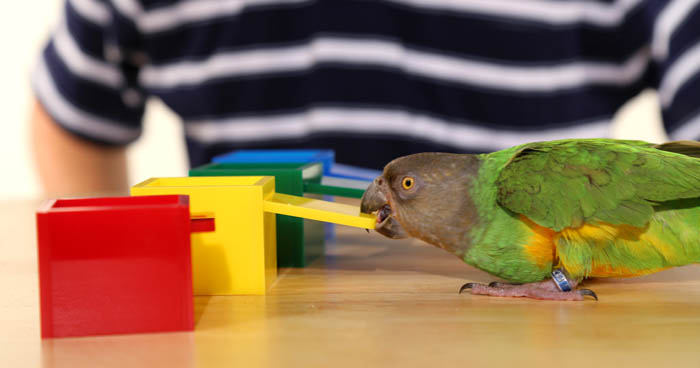 Kili
Type: Senegal Parrot
Genus: Poicephalus
Species: Senegalus
Subspecies: Mesotypus
Sex: Female
Weight: 120 grams
Height: 9 inches
Age: 17 years, 6 months
|
 Truman
Type: Cape Parrot
Genus: Poicephalus
Species:Robustus
Subspecies: Fuscicollis
Sex: Male
Weight: 330 grams
Height: 13 inches
Age: 15 years, 9 months
|
 Rachel
Type: Blue & Gold Macaw
Genus: Ara
Species:ararauna
Sex: Female
Weight: 850 grams
Height: 26 inches
Age: 13 years and 6 months old
|
List of Common Parrots:
Parakeets:
Budgerigar (Budgie)
Alexandrine Parakeet
African Ringneck
Indian Ringneck
Monk Parakeet (Quaker Parrot)
Parrotlets:
Mexican Parrotlet
Green Rumped Parrotlet
Blue Winged Parrotlet
Spectacled Parrotlet
Dusky Billed Parrotlet
Pacific Parrotlet
Yellow Faced Parrotlet
Lovebirds:
Peach Faced Lovebird
Masked Lovebird
Fischer's Lovebird
Lilian's (Nyasa) Lovebird
Black Cheeked Lovebird
Madagascar Lovebird
Abyssinian Lovebird
Red Faced Lovebird
Swindern's Lovebird
Lories and Lorikeets:
Rainbow Lorikeet
Conures:
Sun Conure
Jenday Conure
Cherry Headed Conure
Blue Crowned Conure
Mitred Conure
Patagonian Conure
Green Cheeked Conure
Nanday Conure
Caiques:
Black Headed Caique
White Bellied Caique
Poicephalus Parrots:
Senegal Parrot
Meyer's Parrot
Red Bellied Parrot
Brown Headed Parrot
Jardine's Parrot
Cape Parrot
Ruppell's Parrot
Eclectus:
Eclectus Parrot
African Greys:
Congo African Grey (CAG)
Timneh African Grey (TAG)
Amazons:
Blue Fronted Amazon
Yellow Naped Amazon
Yellow Headed Amazon
Orange Winged Amazon
Yellow Crowned Amazon
Cockatoos:
Cockatiel
Galah (Rose Breasted) Cockatoo
Sulphur Crested Cockatoo
Umbrella Cockatoo
Moluccan Cockatoo
Bare Eyed Cockatoo
Goffin's Cockatoo
Macaws:
Red Shouldered (Hahn's) Macaw
Severe Macaw
Blue And Gold Macaw
Blue Throated Macaw
Military Macaw
Red Fronted Macaw
Scarlet Macaw
Green Winged Macaw
Hyacinth Macaw
Glossary of Common Parrot Terms
|
| | Tuesday September 22nd, 2015 |
|
I have owned parrots since 2008. Now, 7 years later I have 4 parrots, 30,000 subscribers on youtube, over 17 million views, and selling thousands of copies of my book. I would like to thank all of my subscribers, followers, readers, and fans for being a part of the whole Parrot Wizard experience. I am really happy to be sharing this with you and helping you achieve a great relationship with your bird as well.
Most of all I would like to thank my parrots for putting up with all the lights and cameras so that I could share them with you and the world. I have compiled a short sizzle reel to highlight some of the really cool stuff these magnificent performing parrots can do:

Kili knows over 30 tricks and I have actually lost count. The coolest thing is that she just knows how to work with me so I can come up with cool new videos like (Kili Swift Shake it Off) without specifically having to train anything new. We use commands that she is familiar with or she learns her new cues on the spot with a clicker. She is just a star actress.

Truman is a total monkey bird. He is always making a mess or getting into some kind of trouble. Still, he's the most lovable bird in the family and impossible to get mad at. He's very cuddly and hand tame. He is my go to bird for letting people hold. He has literally never bit anyone ever.
Santina is the rescue bird and still working on her skills to get along with other people. She was featured on my Harness Training DVD about how she learned to wear a harness in just a week!
I am working full time being a Parrot Wizard. When I'm not doing shows, consultations, or seminars, I am busy developing new tricks and products to sell. In my Parrot Wizard online store you will find a collection of products I have hand selected or invented to make parrot keeping more enjoyable. Trick training toys, perches, books, DVDs, and Parrot Training Perches can be purchased on that site. My book, The Parrot Wizard's Guide to Well-Behaved Parrots contains my complete approach to parrot training. It is exactly the system I have used on all of my parrots and the system that I recommend to other parrot owners. It is a lot of information so it took an entire book to contain it.
I am available for parrot shows for TV, general audience, or parrot clubs. Please contact me if you are a producer or organizer. I travel a lot, so there are occasionally opportunities to come and see one of my seminars in the US or around the world. I live in New York City and am especially available for events in the area.
You can follow little day to day updates and picture on the Trained Parrot facebook page.
I continue to work on new videos, tricks, and products. Thank you for watching and stay tuned for more exciting blog articles! |
Parrots are extremely intelligent creatures and can learn concepts like colors, matching, and size. That's why I am always excited to teach tricks to my parrots that both challenge them and demonstrate their capabilities to others.
It was pretty easy to teach my new Colored Boxes trick to Kili. That is because she already has all of the skills required to learn the colored boxes trick. First, a parrot needs to know how to fetch. Next, the parrot needs to learn how to match colors. Finally, the parrot needs to learn how to push or pull.
Kili already learned how to match colors in the puzzle trick and ring toss trick. Kili learned to push/pull for a coin box trick and for her stroller trick. Putting all of these skills together led to the Colored Boxes trick. In this trick Kili places all of the round colored pieces into matching colored boxes. Some of the pieces are smaller and some are larger. She had to learn to ignore the size and focus exclusively on matching the colors. Then Kili learned to walk over and push all of the boxes closed.

A problem that I ran into while teaching this trick was that Kili tricked me into helping her figure out where to put the pieces. Out of habit, I was clicking my clicker during the moment Kili would begin to dip the piece into right box. I realized that she would walk around dipping the piece into each box and waiting to see if there would be a click or not. In other words, she was tricking me into determining the color match and just cuing her when to drop it. So to avoid being outsmarted by the bird, I had to pay attention not to click until she would fully release the piece into the right box. She needed to receive the negative punishment of getting nothing for dropping the pieces into the wrong boxes in order to realize which ones are actually right.
When you teach a color match trick like ring toss, puzzle, or colored boxes, in the beginning the bird will only do two or three colors on pure memorization. But as you keep increasing the number of colors, a light bulb comes on in that bird's head and it realizes that the colors have to match regardless of what they are. Then the bird is able to match any color of that style trick.


I recommend the Colored Boxes Trick for any small to medium parrots. It's too small for bigger parrots but the 6 Color Birdie Ring Toss is great for all the medium to large parrots.
Now check out this video of Kili performing her colored boxes trick:
|
Here is a video where Kili and Truman do interviews of different people around Central Park in New York City and what they know about parrots.
|
Oh no! The Parrot Got Out! This is the newest video posted by Parrot Wizard, a short Horror Film about what might happen if the psitta-beast got out of its enclosure. The short film features Marianna Samushiya and the well-known trained Senegal Parrot, Kili. Marianna comes home but soon realizes that she's being followed.
It took several days of filming and even more of editing but I am pleased with the results. I used a mix of techniques to bring you the story and action. From classic pan shots to steadicam tracking, you will enjoy the heart pumping action and terror.
Here are a few behind the scenes looks at the making of The Parrot Got Out:



So dim your lights, set youtube to fullscreen, change the play quality to 4K or HD, and get ready to witness the horror of The Parrot Got Out:
|
Check out Kili's newest trick. Well actually it's not that new but we have not made a video about it before. I taught Kili the bird toss or what I like to call "boing boing." It's a trick in which I can toss Kili up and down in my hand like a beanbag.
The trick first came to me when I was walking about Phoenix with Ginger and her Senegal Parrot Sammy on a harness. Sammy is a really easy going Senegal Parrot that just about anyone can hold. Sammy is the star of Ginger's Parrots Movie. Anyway, so I taught Sammy to wear a harness in no time and we went to a Sunday morning parrot outing with other parrot owners. I was holding Sammy and we were there a while so I started turning Sammy over and playing. I forget why exactly but I started bouncing Sammy up and down in my hand and before you knew it we had a new trick.
Ginger and I passed by Dr. Drigger's office (a well known Avian Veterinarian in the Phoenix area) and I showed him what Sammy could do. The doc thought it was hysterical and took a video.
Fast forward to more recent times. Kili is very good about laying in my hand. So I started preparing her for the bird toss. At first it was just a matter of moving my hand up and down while holding her. But then I started letting go and allowing her to go up out of my hand a little and back down. It's nothing more than a trust building exercise. If Kili gets too uncomfortable, she just flips over and lands on my hand or flies away. But I can see her overcoming her fears in order to earn treats.
The funny thing is that this trick wasn't taught in the usual click and treat method. Instead it would happen here and there in the course of a year. Sometimes just playing with her out of boredom, other times right before putting her in the cage for a meal, little by little Kili learned to bounce like a champ. This was sooner a long term type of training rather than quick accelerated learning. I tried to get her to learn it quickly at first but it just wasn't working. So spanning it out over time without any hurry was the best thing for this type of a trick.
To teach the more basic requisites such as touching, grabbing, and turning your bird over on its back, please refer to my book, The Parrot Wizard's Guide to Well-Behaved Parrots.
An interesting thing I noticed is that both Sammy, Kili, and Truman do better with the bird toss while wearing a harness. Perhaps it's the security they feel of still being partially held (by the harness instead of hand) or something else, but the harness definitely helped get the trick going in the beginning. And without further ado, here's the video:
|
|









 Older Articles
Older Articles  Newer Articles
Newer Articles